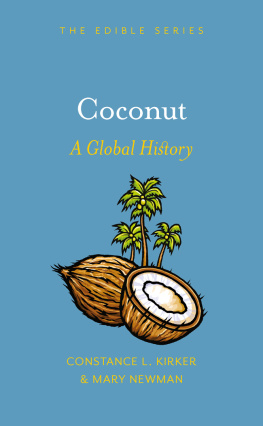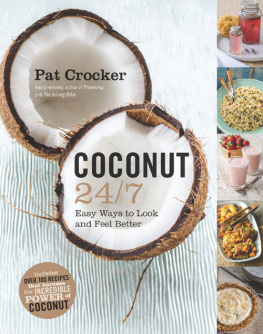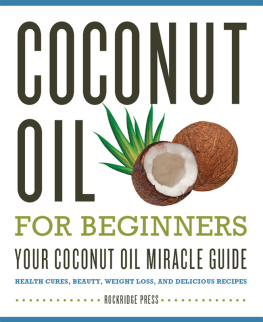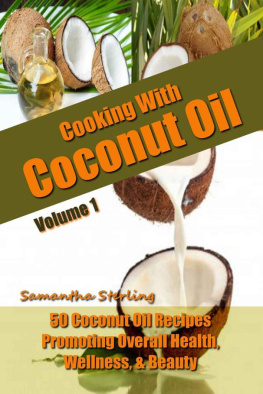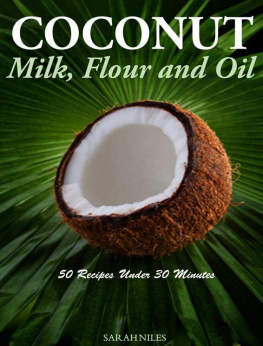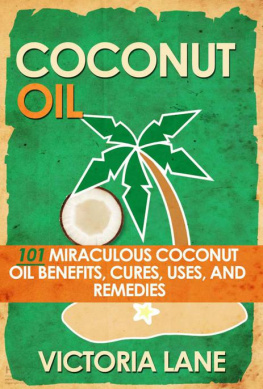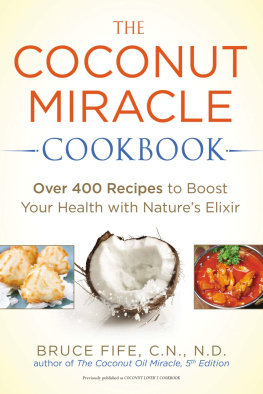The Coconut Bible
The Complete Coconut Reference Guide
From Ancient Mariner to Modern Miracle
Annie Deeter

2015 Annie Deeter. All rights reserved.
First Edition January 2015
All rights reserved. No part of this book may be used or reproduced in any manner whatsoever without written permission except in the case of brief quotations embodied in critical articles and reviews.
Dedication
This book is dedicated to all coconut growers around the world, most especially those who have reintroduced traditional growing practices that are sustainable and environmentally sound while preserving the highest nutritional value of their coconut products. It is also dedicated to Mary G. Enig, Ph.D., whose pioneering and selfless dedication to the truth has provided us with the knowledge of the incredible health-giving power of the coconut.
Table of Contents
Publisher's Note
The author and publisher have used their best efforts in preparing this book. This book is intended to provide helpful and informative material. It is not intended to diagnose, treat, cure or prevent any health problem or condition. It is not intended to replace the advice of a physician.
No action should be taken based solely upon the contents of this book. Always consult your physician or qualified health professional on any matters regarding your health and before adopting any suggestions in this book, or drawing inferences from it.
The author and publisher specifically disclaim all responsibility for any liability, loss or risk, personal or otherwise which is incurred directly or otherwise as a consequence, directly or indirectly from the use or application of any contents of this book.
Any and all product names referred to within this book are the trademark of their respective owners. None of these owners have supported, endorsed, authorized or approved this book.
Always read all information provided by the manufacturer's product manuals and labels before using their products. The author and publisher are not responsible for claims made by manufacturers.
This book is copyrighted by Annie Deeter.
Introduction
Current events might lead one to think of the coconut as just another passing fad in a fickle culture largely disconnected from the natural world. The Tetra Paks of coconut water and conveniently packaged coconut oil mark the landscape of our passing.
We relegate the bounty of the coconut to elitist consumer products for the over-indulged health-obsessed first world consumer. In perfect denial of our dependence upon the natural world, we label the market trend as a passing fad and go on about the business of our lives.
Against this backdrop, the coconut stands like a sort of beacon, an anomaly, reminding us not only of the power of nature to heal us but also of our long term relationship with it.
For those in the largely third world nations throughout the tropics where coconuts thrive and are cultivated it is anything but an elitist consumable. It is a staple, an integral part of daily life. It provides food, drink, shelter and a constant connection to a natural world that while not abundant in the global economic definition of profits and excess is perfectly abundant in its provision of what is needed for healthy life.
Outside of those tropical regions, it is easy enough to ignore. It is easy enough to pretend, as we do so well, for the most part, that nothing that nature produces is essential to our well-being. The message of the coconut is precisely the opposite of this construct of our reality.
We fall into mega-trends driven by marketing, profits and producers. Those things we need in our daily lives are designated as consumables provided to us by market forces.
But the truth is much deeper than this. Our world is a natural paradise of clean air, fresh water and unrelenting sunshine which provides us with every requirement necessary to life. Air we can breathe, water we can drink and plants and animals we can eat. Each the result of complex biological systems maintained in perfect balance for millennia. Weve known the coconut, as it turns out, for a very long time. It has a significant and powerful history in our modern and ancient past.
Far from some passing trend, coconut has been a major player in culture, health, healing and nourishment of humans going back pretty much as far as we can see - and in fact, further than we can see. Beyond the mists of time when ocean levels rose and fell according to ice ages and primordial floods and shifting tectonic plates. There, in the earliest of days which contained oxygen and sunlight and plants, cocos nucifera began its evolutionary journey. A journey which has brought it into the hands of some of the earliest of humans, into their crude rafts and earliest ocean going vessels and across the vast oceans of water and of time, into the modern age.
The coconut has provided oil for cooking and for light for longer than there are written records to document its uses. Named as a healing plant in the worlds oldest recorded medicinal writings, and honored for its nearly limitless uses which include every part of the plant and its fruit, the coconut embodies a symbolism and depth of relationship with man that is nearly unsurpassed in the plant kingdom.
Now, in the midst of seemingly numberless devastating environmental crises, and rapidly declining health of many peoples around the world, the coconut returns to our awareness. It reminds us once more of the bounty of nature, the power of simplicity and of traditional practices and last but certainly not least, of the generosity and wisdom of nature.
Part I:
GETTING TO KNOW THE COCONUT
Chapter 1: Coconut Origins & Ancient History - Coconut the Ancient Mariner
Coconuts may be one of the most fascinating and diversely useful plants in the world. They are also one of the oldest. The fossil record of coconuts goes back literally tens of millions of years.
Widely identified as a type of palm tree, the coconut, like all palms, is not really a tree at all. The fronds of the coconut are actually leaves. What we think of as the trunk is actually its single stem.
Botanically, the coconut is a woody perennial monocotyledon. It has no bark and no true branches.
It might seem that such an ancient plant would be relegated to the annals of history and no longer useful in the modern world, but in the case of the coconut, just the opposite is true.
Coconuts most likely evolved on the shores of lagoons surrounding coral reef islands. Their adaptation to the shoreline provided access to the fresh water lens just beneath the surface of the rocky beach, above the high tide line. Here their roots could tap the fresh water which pools above the salt water table beneath the sands.
Whether they evolved during the break-up of the great super-continents or just after is unknown. But the natural territorial range of the coconut, as well as its coastal habit, suggest it could well have evolved during the Cretaceous period as India was separating from the main landmass of Gondwana. The oldest wild cocos forms could well have evolved along the coastal waters of the Tethys Sea as the once solid landmass of Pangaea began to break up, creating inland waterways around the Tethys Sea between what would become India, Madagascar, Australia, Antarctica and Eastern Africa.
We may never know the true place of origin of the coconut, with its most closely related cousins in South America and its widest variety of forms in the Asiatic Pacific Ocean; it still has no truly Asian form.
What we do know with some degree of certainty is that the coral reef atoll is the oldest and most stable ecosystem on earth, and the coconut palm is its most successful plant form.
Next page


